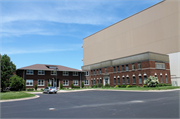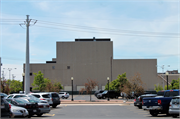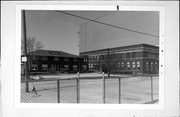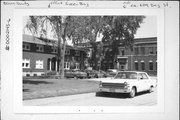| Additional Information: | Photo code #2: 75BR-13/32
Earlier hip roofed building with fine arcaded entrance has a later flat roof rectangular addition built in 1931 as a laboratory. The earlier building has an inset entrance porch in the center of the facade with three semi-circular arched openings supported by Tuscan Order columns giving access to it. All windows in this building are 1/1 lite and are paired. The wide hip roof gives the building a marked domestic feeling, unlike the later period revival inspired design of the laboratory addition.
The windows in this addition are of metal sash with a 8 lite transom above 10 lite paired casement windows. These windows on the first floor have blind semi-circular arches above with concrete keystones above.
#650: Numerous industrial buildings surveyed separately as Ca. 700 Day Street.
Fox River Valley Industrial Survey
Northern Paper Mill, located at 500 Day Street in Green Bay, was established by Michael J. McCormick, W.P. Wagner, and Iver J. Terp in 1901 at the junction of the East and Fox Rivers on land previously occupied by the Murphy Lumber Company. The company had only 25 employees at first and was producing 800 tons of paper annually during the first five years of operation. The company expanded in 1904, and again in 1910, when it filled in the surrounding swamps to provide more land for development and storage. A sulphite mill was built adjacent to the wood pulp mill in 1916.
In 1919, a large addition for added papermaking machines was completed, and, in 1921, a ground wood mill was finished. The addition of these paper machines made Northern the largest tissue manufacturer in the world for the following two decades. Northern Paper Mills produced all grades of rolled towels, napkins, and wrapping, but became most known for their brand of toilet paper “Northern Tissue” during the 1920s. Advertising at the time stressed the softness and cleanliness of the product.
In 1928, a large three-story storage building was added to the site north of the gabled roof brick buildings that preceded it. During the 1930s, the basic form of the Northern Mill was set with a number of production line buildings and warehouses oriented adjacent to each other on an east-west axis with a laboratory and office set off to the east. The laboratory was completed in 1929, and the hipped roof office building was constructed in 1931. The company employed over 300 people by 1932. The gatehouse and general storage facilities were added by the end of World War II. New paper making machines were installed in the 1950s along with added converting equipment, storage, loading, office space, and a print shop. Two-ply toilet paper was introduced in the 1960s, and Northern continued to be a leader in the toilet paper industry and employed over 1,200 people in the 1960s and 1970s.
Early packaging and advertising for the company stressed a northern aesthetic of pine trees and snow. In the post war years, “American Beauties” and “Living Dolls” were featured with soft watercolor painted images of young girls with kitten and flower bouquets. Northern was purchased by Georgia-Pacific in 2002 and was sold again to a part of Koch Industries in 2005. The mill presently produces 70,000 tons of paper each year and employs 275 people.
Similar to some of the other large and active paper mills in the survey, the Northern Paper Mill is covered with a sprawling series of buildings and additions spanning a history from the turn of the century to the present. With this in mind, access to the rest of the complex and further study would be required to determine eligibility of the entire site. However, The Northern Paper Mills Office and Laboratory, completed in 1931 and 1929 respectively, and located near the eastern end of the mill site, are significant under Criterion A: History in the area of Industry for their role in the Green Bay paper industry. The period of significance for these buildings would extend from 1929 to circa 1970, approximately fifty years ago.
Green Bay Intensive Survey Phases 2, 3 & 4 |
|---|





